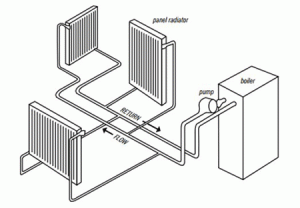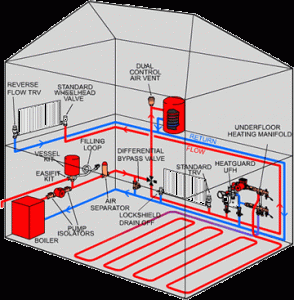Hydronic or Steam Boiler Heating Systems – Pros and Cons
Air Conditioning FAQs
If you are looking at a hydronic system, how it works is as follows-
- Heats water and boiled to certain temperature.
- Moves through sealed pipes to radiators throughout the home.
- Gives the home constant warmth.
- Keeps the chill out of the air as it uses a thermostat.
- Recirculates hot water.
- Uses panels or in-slab.
- Heated by natural gas/solid fuel/LPG.
Pros of hydronic heating systems
- Hypo-Allergenic meaning less dust.
- Healthier.
- It’s completely silent.
- Highly efficient (up to 95%).
- Great for ongoing efficiency.
- Zones the heating to only the areas you want heated.
- Water is a better heat conductor than air.
- Uses water which is recycled so you don’t use a lot.
- Comfortable and gentle heat which warms the whole house.
- Can leave it running all winter long.
- Far less expensive energy bills.
- Reliable.
- Attractive-huge range of styles and designs.
- Many come with long warranties.
- Child proof due to mild temperatures and safe to touch.
- Wall system doesn’t get too hot to touch
- Completely silent.
- Worthy investment over time.

Cons of hydronic heating systems
- Initial cost is quite expensive.
- It only heats and doesn’t cool.
- Building work involved for installation can be quite pricy.
- It can take up to half an hour to respond.
- Retrofitting a hydronic system isn’t recommended for underfloor systems.
- Doesn’t provide instant heat once turned on.
- It isn’t as efficient if you put furniture against the panels.
If you are looking at a steam boiler system, how it works is as follows-
- A boiler is used to create the steam.
- Steam travels through the pipes in the homes’ walls.
- Circulates it to radiators.
- Gives off heat.
- Warms the room.
Pros of steam heating systems
- Home is heated evenly.
- If you have a larger house you can turn off the heat to rooms not being occupied.
- Can control to certain zones of the home.
- Virtually silent.
- Don’t hear air blowing through the vents throughout the day.
- Cost less to run than forced air systems.
- Can cut back on overall heating charges.
- Can be installed underneath floors.
- Clean.
- Hypo-allergenic.
- Less maintenance involved.
- No filters to change.
- More comfortable heating such as warm floors in winter.
Cons of steam heating systems
- Can be more expensive to install.
- Have to run pipes through the home especially for this system.
- Takes longer for heat to come on.
- Waiting time of pipes to warm up which could take quite a while if it’s a cold day.
How the boiler heating systems are installed
- Radiator panels can be fit to most homes with sub floor access.
- Pipework is put through subfloor.
- Finishes at panel location.
- Include builder’s costs to resurface floors.
- Installation is simple.
- Panel with heating element built into subfloor.
- Covered with a vent.
- Panel sits in a box.
- Needs to be well insulated.
- Vent which covers it can be made of different materials such as aluminium/timber.
- Can choose timber to match your floors.
- Timber held together by aluminium frame.
- Boiler needs a good ventilated outdoor area and pump to circulate water.
- You may need to consider an upgrade to your gas pipe.
- You can install a thermostat in one or several locations in the home.
- Each thermostat control panel is controlled separately per room.
- If you are installing a new floor, slab heating can be considered.
- Pipes laid evenly over the slab.
- Topped with final layer of concrete.
- Slab then finished/polished with tiles.
How much do the radiator panels cost to install?
As a general indication of price to install, a home with three bedrooms, which has about eight panels and good floor access, would costroughly between $7-10,000. A little less labour costs for a new build. If you were to have in-slab heating, you’d need to allowapproximately $60 per square metre if you were fitting a place with about 120 square metres.
How much will a hydronic heating system cost to run?
- In a medium sized house of around 160 square metres it may cost about $1045-$1255.
- They are less to run than other heaters. Roughly 35% per cost effective than running a ducted system.
- They don’t have star ratings, but higher star ratings can save significant money.
- These are just average costs.
- They don’t indicate how long the heater is being used for.
- You can leave it on all day and running costs will be lower than reverse cycle air conditioning or gas ducted heating.
- They are less expensive than either reverse cycle or gas ducted systems.
- You should measure the costs over certain amounts of years and hours it’s being used.
How much will a hydronic heating system cost to install?
- They can cost anywhere from $2500-$3000.
- That doesn’t include installation costs.
- It can take around 12 hours to install a wall mounted system.
- Installation for that could be anywhere from $695 to $875.
- Total price could be anywhere between $3470 to $4200.
- This would be the price for a new home.
- Because of the labour involved, retrofitting a hydronic heating system may cost more due to the extra labour needed.

GET A SERVICE OR REPAIR!
Simply fill in the form below & you'll receive a call from our team to organise your service or repair within 24 hours
